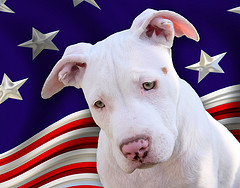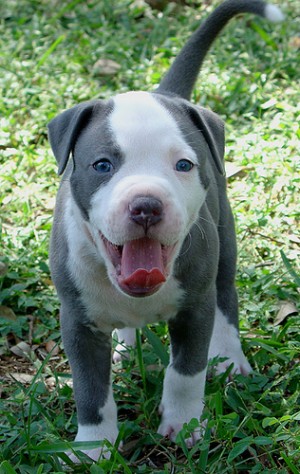Pit Bulls: From America’s Dog to Public Enemy #1
Do a news search for “pit bulls” and you’ll notice certain themes: neglect, dog bites, as well as proposals to ban them. No type of dog arouses more emotion than those identified– and misidentified– as Pits bulls. Yet a century ago, these dogs were so admired for their loyalty and bravery that they were considered “America’s Dog” and used on posters during World War I to sell war bonds and recruit for the U.S. military. Before that, Pit bulls were prized for their gentle disposition and willingness to watch over children whose parents were busy at work, in the fields. So how did a dog which was once respected become so feared?
President and CEO of the Washington Humane Society Lisa LaFontaine says, “If you take a historical look at the breeds involved in dog attacks, the dogs that had been trained by certain elements of society to be aggressive were the pariah breeds of their era.”
LaFontaine explains that during the era of slavery, “Attacks by Bloodhounds were common because Bloodhounds were used to track runaway slaves. They were used to doing something violent. Fast forward to the 1880s and New York City, where Newfoundlands were being used to guard markets, so a preponderance of bites came from Newfoundlands. After World War II, Dobermans were associated with Nazis and were seen as dangerous.
“It was really when gangs adopted Pit bulls that they became the latest pariah…these happy, healthy, well-adjusted dogs became a symbol of drug culture and violence because unfortunately, you can take all of a Pit’s positive traits and turn them negative.”
Some may ask, what positive traits does a Pit bull have? Once again, history provides answers– and some surprising examples of great, if not heroic dogs. The only dog ever to be promoted to the rank of “Sergeant” started out as a brindle puppy with an abbreviated tail, a trait which inspired his name, “Stubby”.
Stubby, who learned to salute other soldiers by touching his right paw to his eye, served as the mascot of the 102nd Infantry, 26th Yankee Division. When his Division was ordered to war, Stubby was smuggled to France aboard the SS Minnesota. Ironically, Stubby’s first injury ended up making him a valuable asset on the field; after being exposed to gas and becoming ill, Stubby was acutely sensitive to it– a skill which came in handy during a pre-dawn gas attack, which occurred when his Division was asleep. Stubby barked and nipped at his men, waking them and thwarting the attack.

Flickr: Beverly & Pack
Pit bulls were used on World War I-era posters to promote war bonds and recruitment.
Later, when a German spy tried to map his camp, Stubby was there. The German soldier tried to greet him, and Stubby responded to his overture by barking. The spy ran and Stubby attacked him until reinforcements arrived. Stubby’s capture of an enemy soldier resulted in his promotion to the rank of Sergeant. Later on, when his master J. Robert Conroy started law school at Georgetown University, Stubby– not the iconic bulldog we associate with the Hoyas today– was there. Some even say that Stubby may be the genesis of the half-time show, since he often delighted spectators by nudging a football around the field with his nose.
Sergeant Stubby was no pariah– but he was a Pit bull. So what changed? Lisa LaFontaine of the Washington Humane Society says we did. “The imagery around Pits had to do with drug culture and gangs, so they became known as an ‘urban dog’. There was an infamous Sports Illustrated cover…and that imagery was planted.”
In the summer of 1987, Sports Illustrated declared “BEWARE OF THIS DOG” on its cover– and underneath those words a brindle Pit bull snarled, teeth bared, to emphasize that warning. That imagery appealed to the worst elements of society, and a loyal, people-pleasing dog found itself guarding gangs, not children or Allied soldiers. The ASPCA says that Pit bulls’ “intimidating appearance” make them “attractive to people looking for a macho status symbol, and this popularity has encouraged unscrupulous breeders to produce puppies without maintaining the pit bull’s typical good nature with people.”
Detractors of the breed point to its popularity in dog fighting as proof that the animals are inherently dangerous to people, but Pit bulls were originally bred to be extra gentle to humans, so their handlers could easily separate them, during fights. According to the ASPCA, “Poor training and poor breeding are, in part, responsible for the increasing numbers of pit bulls and pit bull mixes involved in attacks against people.”
Despite the breed’s impressive history, there is a perception that dogs like Sergeant Stubby are different from the Pit bulls we see today, on the news and in our neighborhoods. While indiscriminate breeding by unscrupulous humans has adversely affected the breed, Pit bull heroics are not a thing of the past. In 2001, three Sacramento-based Search and Rescue dogs named Tahoe, Cheyenne, and Dakota worked indefatigably at Ground Zero to find survivors; that was just one of the 200 missions the trio of Pit bulls have completed. Despite negative press, threats of Breed-specific legislation and their status as outcasts, America’s dog still lives to serve.
-
http://www.facebook.com/pamalie.w.reynolds Pamalie W. Reynolds
-
Pawzitive Petz
-
Eileen
-
Eileen
-
http://DCentric.org Anna John
-
http://DCentric.org Anna John
-
http://twitter.com/msgeek93 Michelle Hass
-
Jam7ira
-
http://DCentric.org Anna John
-
http://www.facebook.com/profile.php?id=654166977 Shawn Lowe
-
Ffraugee
-
Lawyer2b01
-
Lee0923
-
Sweetsouthergal
-
pitbullmommy
-
Debjoling
-
Diane
-
Tambrathegreat
-
Nevaeh
-
Renda82
-
Tlinskey
-
JazzJenn
-
Lyn, Nikki’s friend. HI Nikki!
-
keith
-
Inman9124
-
Picklelily6330
-
Nate





